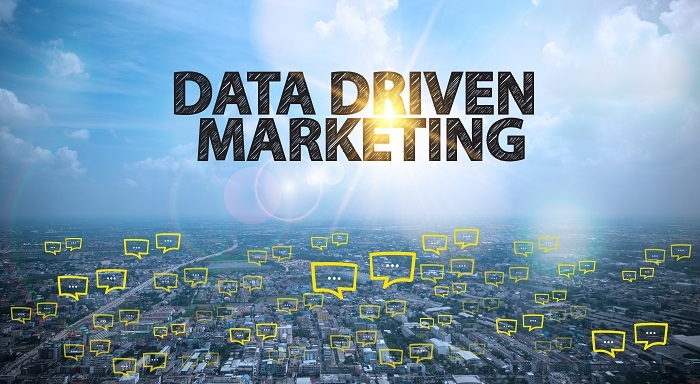
 Data Structure
Data Structure Networking
Networking RDBMS
RDBMS Operating System
Operating System Java
Java MS Excel
MS Excel iOS
iOS HTML
HTML CSS
CSS Android
Android Python
Python C Programming
C Programming C++
C++ C#
C# MongoDB
MongoDB MySQL
MySQL Javascript
Javascript PHP
PHP
- Selected Reading
- UPSC IAS Exams Notes
- Developer's Best Practices
- Questions and Answers
- Effective Resume Writing
- HR Interview Questions
- Computer Glossary
- Who is Who
Using Data-Driven Marketing to Help Your Company’s Digital Transformation
Data-driven marketing is the notion of harnessing user data for optimum and targeted media buys and new communications. It is one of the most seismic shocks in the history of digital advertising. Though information business was historically uncommon, the proliferation of specialized media outlets and changing customer expectations have made data analysis a crucial element in current marketing operations. Companies may fine-tune their efforts based on some of these insights to achieve the finest customer experiences and the most value on advertising costs.

Benefits of Data-Driven Marketing
In the programmatic buying industry, data-driven marketing is most likely one of the most sophisticated. Marketing companies and advertisers are eliminating much of the uncertainty from media planning and buying by employing analytics and computational.
Ad spending and marketing messages are adjusted to be presented exclusively to the relevant promotional objectives. The era of one-targeted advertisements is ended. Some firms can still benefit from significant concepts, but for the most part, marketing communications must become increasingly specific in order to be relevant enough to engage with customers. The increased personalization provided by research marketing fosters social commerce while generating a pleasant digital experience.
Where & How to Use It?
Today data-driven marketing began with the launch of customer relationship management (CRM) software. CRMs enable marketers to keep users up to date users, particularly their contact details and their names. CRM paved the way for a new industry, a web analytics system, which gave rise to computerized content marketing. Inventory management software and Eloqua are two examples of pioneers in this field. They lead the creation of business strategy profiles based on consumer contact tracking via the website and email. This client profile enables automatic messaging depending on certain triggers and actions, as well as the segmentation of possibilities.
Users are now followed not just through corporate media on merchant webpages and messages, but also through bought news as advertisements were running?a technique known as digital marketing. It emerged to assist marketers in aggregating data in a more manageable manner and producing additional insight for new marketing and artistic initiatives.
Creative Thought Power in Data-driven Marketing
It might be published by any company in that media organization. Architects "created" an inventive file and oversaw its presentation. After the document was handed forward, its fate was sealed. In latest years, several companies, like Instagram, have developed new styles that need the download of numerous different materials in order for the author to produce the final ad. This was dubbed "posting" a native ad or creative. The content is a collection of objects and environments that are given to the client within the circumstances of the channel in which it is appearing.
Also with the convergence of artistic, marketing, and analytics, advertisers like to tailor the content depending on the individuals who are consuming it and how they are watching it happen. Rich media advertising that is invasive is vanishing, making way for exciting new patterns in far more client forms that leverage text personalization rather than invasion to attract headlines.
Using social media is no longer the first and only route via which everything above is achievable. About every part of the client experience can always be tailored thanks to algorithmic branding and promotion technology.

Challenges in Data-Driven Marketing
To establish a data-driven plan, you must put the proper data methods in place. This ensures that your actions and policy are based on accurate data which is indicative of client demands. If your statistics do not meet data performance standards such as punctuality, correctness, fullness, generalizability, and so on, you risk passing judgment solely on information that gives little insight into your users' true needs. In reality, over a quarter of newly collected data get at minimum one major inaccuracy, and Harvard business research found that just 3% of data integrity ratings are satisfactory. In light of this mind, advertising agencies must confirm that they possess data integrity requirements and guidelines in place prior to starting on statistical methods.
Data-Driven Leads to Information
Many businesses have invested in big data (sometimes various funding), but have yet to receive a clear return on their efforts. If you acquire a large amount of information without the proper facts, it's going to have a minimal impact on your business plan. Although 70% of marketing and promotional leaders consider data-driven advertising to be a vital goal, just approximately 2% have gained a positive benefit from engaging in these technologies. Businesses must have the proper individuals, procedures, and technology in place to make the greatest use of their statistics. This includes data analysts who can advance from large data, data cleaning techniques, and the required software vendors to filter, analyze, and analyze enormous amounts of information.
Establishing a statistics business strategy requires time and money because advertising agencies must guarantee that the appropriate rules and policies have been established. While advertising agencies frequently find the task more difficult, the benefits are eventually worthwhile.
Though if your organization has the necessary personnel and equipment, determining where to begin can be tough. Before embarking on their journey, advertising agencies should ensure they include a comprehensive plan in place or work with a second string that really can advise them on how to get the most value from your statistics.

Steps in Data-Driven Marketing
It will be determined by the system's aim. You will prioritize gathering business data if you are attempting to construct people's personal profiles. Concentrate on correlation information if you want to follow the route to acquisition and user experience. Following the establishment of your target, ensure that you could have set Metrics that might help you to evaluate the achievement of your program.
It's vital to comprehend what you're attempting to accomplish by using the data. Work with the company data scientists team to identify any holes in the present information and establish how or when to fill such discrepancies in order to assess Metrics and go ahead.
Similarly, you won't immediately experience favorable outcomes if your statistics approach is built on erroneous or inadequate data. In that reality, you hazard altering advertising in ways that deviate from the impression your customers desire. Create explicit data integrity policies to lower this risk. This ensures that your selections are founded on the latest recent and relevant facts at hand. Establish rules across sectors to guarantee that each group records the same data in the exact same manner.
Conclusion
Expectations of customers now necessitate statistics marketing, particularly knowing the ever-increasing number of platforms, software, and technologies via which to contact them. These strategies, if completed, enable you to leverage the potential of your analytics by delivering tailored customer interaction, optimizing spending, and achieving better ROI.

